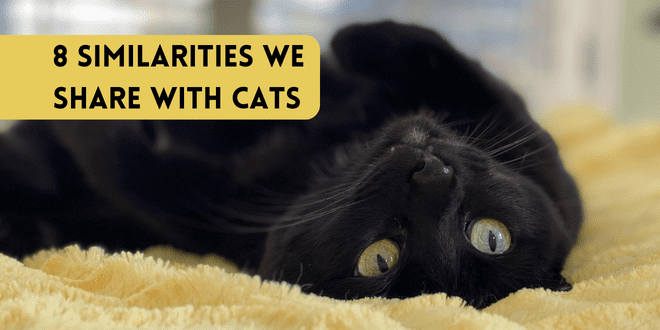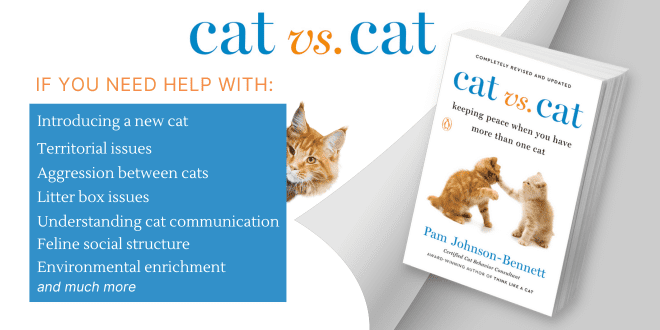
For most of us, cats are beloved members of our family and cherished companions. We appreciate the beauty, joy, love and fun that cats share with us. For some people though, cats are viewed as untrainable, sneaky, cold, and destructive animals. I feel bad for those people who are missing out on all that cats add to our lives.
We actually share some similarities with cats. For the people who haven’t been able to relate to cats yet, maybe learning about a few of the things we have in common with these intelligent and loving creatures will soften their hearts a bit. Here are just some of ways in which we’re similar:
1. We Enjoy Affection and Companionship
It surprises many people when they learn that cats are social animals. Although mistakenly labeled as solitary, cats benefit from social interaction just as we do. Cats are solitary hunters because they go after small prey and this is probably where the misconception begins. They’re also territorial so social interaction initially requires finesse, but they are social. Just because cats don’t exhibit instant social ease the way two unfamiliar dogs might doesn’t mean they don’t have a social structure. A cat’s social structure is based on resource availability.
Cats also display affection but each cat may exhibit it in different ways. People show affection in various ways as well; we aren’t all the same. Some people enjoy being physically close and like to be hugged and some don’t. Cats can be like that as well. Just as with people, some cats prefer a gentle, casual touch over a long, close embrace or hug. A cat may give an affectionate display in the form of sitting nearby or being on a lap without being held or confined. Some people show their love and affection through acts of kindness, thoughtfulness, or words as opposed to close physical contact. When it comes to cats, it can be easy to miss subtle signs of companionship and affection. Your cat’s purr, a slow eye blink, relaxed posture or desire to sit close to you are displays of affection. The cat may lean his body against yours, touch your face with hispaw or place a paw on your arm, rub his face on you, or give you a gentle (or not so gentle) head bunt. Again, these are signs of affection that are easily overlooked. Just as with your human companions, pay attention to individual preferences and displays. Some are grand and hard to miss and others are subtle, yet no less meaningful.
2. We Learn the Same Way
When it comes to behavior, consequence plays a big role. If a behavior is rewarding it will most likely get repeated. When you were a child, wasn’t it helpful to have consistent rules and know that you were being taught and guided with love? Consistency is important to humans and to cats. It’s easier to learn and follow rules when you know what’s expected of you and that rules aren’t being changed from one day to the other. Using physical punishment and intimidation just creates fear and can damage the emotional bond, whether training a cat or a child. To train your cat, create a roadmap to help your cat succeed.
3. We Like Having Choices
Nobody likes to feel backed in a corner without any options. We prefer having the ability to make choices about aspects of our lives and cats feel that way as well. Training has a better chance of being successful if you offer choice. When you don’t want a cat to do a particular thing, it’s more productive to understand the motive behind the behavior so you can offer a better option. That method helps with people as well. Having choices reduces frustration and helps the person or cat feel as if they have some degree of control over their own behavior. Here are a few examples of how to offer choice to your cat.
- Give your cat the option to stay in the cat carrier during veterinary exams by using a carrier with a removable top.
- Give your cat the option to choose an allowable elevated location by providing cat trees or window perches instead of just shooing him off counters or furniture.
- Give your cat the option to choose how close he wants to be by observing body language and letting him set the pace of interaction.
- In a multicat household, give your cats the option to use a litter box that provides the degree of security they need by having multiple boxes in various locations around the house.
- Provide open and hidden napping areas so your cat has the choice of his level of visibility.
4. We Need to Play
With humans, it can be anything from board or video games to competitive sports. Don’t underestimate the value of having fun because it actually helps release dopamine which is a neurotransmitter associated with feeling good. Playtime helps humans learn, reduce stress, strengthen bonds and maintain physical well-being overall.
Playtime for a cat typically involves mock hunting by stalking and pouncing on toys. Just as with humans, when cats play there is a release of that beneficial dopamine. Playtime for a cat helps build confidence, maintain good body conditioning, reduce stress, strengthen bonds with other companion animals or with humans and it’s an important tool in overall environmental enrichment. Playtime is one of the best ways to build trust when working with a frightened or shy cat. We all need playtime in our lives no matter what our age.
5. We Benefit from Enrichment
Without enrichment humans and cats can become susceptible to boredom, depression, loneliness or frustration. Enrichment for humans encompasses a wide variety of options such as music, books, movies, TV, outings, time with friends or family, sports, and so on. Cats need enrichment as well and it’s actually very easy because you don’t have to worry about taking kitty out for dinner and a movie. Enrichment involves creating a safe and healthy home, opportunities for daily playtime, interaction with you, places to climb, nap, scratch, stretch and have fun (such as cat trees, scratching posts, beds, perches, etc), good nutrition, veterinary care, access to resources that are adequate in number and conveniently located, and training based on love and understanding of what a cat needs.
6. We are Protective of What is Ours
We lock our houses and our cars. We write our names on items so others will know what belongs to us. We keep close watch over our personal items such as purses, wallets, phones, money, and credit cards. We’re careful about the people we let in our homes. We use security systems and/or surveillance cameras. We protect our children. For cats, the fact that you have the house locked doesn’t mean much. Cats don’t know whether danger is lurking around every corner. Danger can be found in the fact that a companion cat is resource-guarding the feeding station so no one else can get to it. Perhaps the danger is that in order to use the litter box, a cat has to pass the family’s very aggressive dog who consistently attacks. Maybe a new cat has been brought home and the resident cat is totally freaked out at the possibility of this intruder taking over the territory, stealing resources and threatening their safety.
Cats and humans both want the feeling and comfort of safety and security. The individual priorities may differ but the fact is we all want to live our daily lives without the fear of threat.
7. We Like Our Personal Space to be Respected
When you get in an elevator and there’s another person already in it, your natural tendency is to stand on the opposite side. People prefer to space themselves in public situations, whether it’s on a bus, train or in a waiting room. Nobody likes to have their private space violated. Even at home, members of the family may have preferred seating areas when it comes to watching TV at night. Some people are comfortable being very close and others want a little more breathing room. Cats are the same way. Cats have a need for personal space and it’s important to watch their body language to see whether they’re giving an indication that a decrease in distance is desired or not. Where misunderstandings occur is when people don’t give cats any choice or they don’t observe clear body signals.

8. We Find Comfort in Familiarity
Change is often scary for most people, whether it’s a move to a new city or starting a new job. Familiarity and predictability in everyday life are reassuring and comforting for humans as well as cats. Even though we may not enjoy change, for the most part, we do get some kind of warning so we can prepare. We also know the fear we face regarding change is usually temporary. For cats though, change comes without warning and it can be truly frightening. A cat doesn’t understand why they have suddenly been shoved in a carrier and then is let out in a new and totally unfamiliar home. A cat doesn’t get a say in whether the family is going to expand by the addition of a new baby or a new pet. The cat is often taken by surprise when it comes to life changes whether they’re small or large. Change, even when it’s for the good, is still a scary process. Cats will be the first to tell you that.
Enjoy the Similarities and be Understanding of the Differences
Learn to look at your cat’s world through their eyes and you’ll begin to see the true motivation behind behaviors. You’ll start to appreciate the feelings, fears and needs you have in common with your cat. You’ll also get a better understanding of how cats differ from humans so you can stop assuming incorrect motivations (such as assuming the reason for a cat’s behavior is based on spite or a deliberate act of disobedience). Look at cats for what is beautifully unique about them but also what we share in common with them.
Need More Information?
To understand more about cat behavior and training, refer to the books by best-selling author and cat expert, Pam Johnson-Bennett. Pam’s books are available at bookstores and online. We’ve included links to Amazon here on our website.




